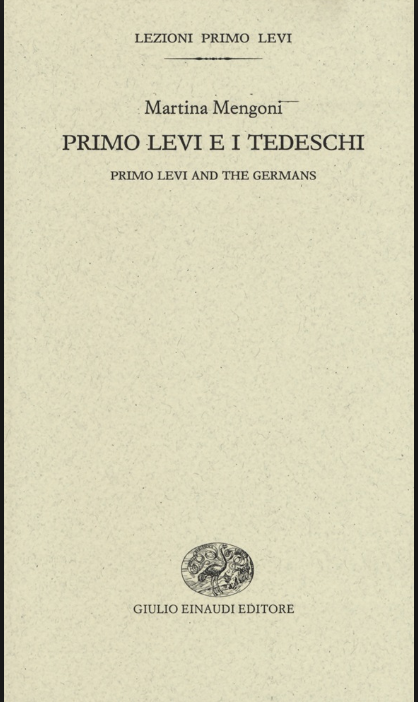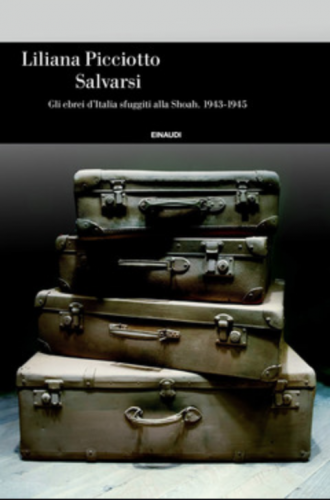
Primo Levi e i tedeschi [Primo Levi and the Germans] by Martina Mengoni is the eighth volume in the Lezioni Primo Levi series, the published versions of the annual lectures sponsored by the Turin-based Centro Internazionale di Studi Primo Levi. Like the preceding volumes, this one supplements Mengoni’s original Italian version of the lecture with facing page translations in English, this time ably executed by Gail McDowell.
“Who were the Germans for Primo Levi?” (p. 10). Mengoni introduces her topic by posing this apparently reductive or merely provocative question, and then proceeds to offer a richly complex response over the course of seven chapters. Certainly, Mengoni explains, Levi would always remember “the Germans” collectively as his tormentors: he mentions them, without any qualifiers such as “these particular Nazi Germans,” more than thirty times in If This Is a Man (p. 54). Even thirty years after the Holocaust, Levi still seemed committed to this undifferentiated notion of the perpetrators: in the appendix to the 1976 edition of his Auschwitz memoir, four of the eight habitual questions posed by students and answered by Levi invoke “the Germans,” along with their deep-seated anti-Semitism and their extermination camps (p. 56). However, over the course of his life, individual Germans (and Austrians) were among Levi’s favorite authors, such as Thomas Mann and Heinrich Heine, and included some of his literary collaborators and esteemed correspondents. There were also Holocaust writers and historians, such as Jean Améry and Hermann Langbein, who greatly influenced Levi’s understanding of the traumatic history he experienced personally. (Mengoni’s volume includes a helpful list of more than twenty German-language authors about whom Levi first learned from his German correspondents, and who were later mentioned in his own published works.)
Mengoni devotes an entire chapter – and with good reason -- to the German translation of If This Is a Man and its 1961 publication by Fischer Verlag under the title Ist das ein Mensch? It was the first autobiographical account by an Auschwitz survivor offered by a major West German publishing house. In the “Letters from Germans” chapter of The Drowned and the Saved, Levi himself wrote about his wonderfully successful collaboration with translator Heinz Riedt, whose accurate and sensitive work overcame the Italian author’s initial mistrust. Mengoni enhances our understanding of this partnership by drawing upon the largely unpublished Levi-Riedt correspondence, held at the Wiener Library in London. In the nineteen letters exchanged, all of them in Italian, we observe our author engage in “self-commentary, the first in a genre in which Levi would excel and which he would increasingly master” (p. 24). Noting Levi’s strong hand in the translation process, and his nearly obsessive search for the best German equivalents for his Italian usages, Mengoni raises a fascinating, ultimately unanswerable question: “Is If This Is a Man a book of ‘total self-control’ right from the start, or did its German translation force Levi to reflect on his own choices and, thus, to justify and defend them?” (p. 24). Of course, the Italian text is itself a kind of translation since so many of the crucial words Levi heard in Auschwitz, and in some cases used himself, were German (but also, I would add, were Polish and Yiddish). Mengoni concludes perceptively that the memoir’s “full linguistic complexity…only emerges before the mirror of its double mother tongue: of its German version” (p. 32).
In the preface to Ist das ein Mensch? Levi expressed his hope that the book would produce an echo which, in a rebound from the north, might help him understand the perplexing Germans. Several of his German readers wrote to him in the 1960s and tried, with various degrees of insight and willful blindness, to explain the rise of Nazism or to confess their utter inability to account for it. In this latter group was Wolfgang Beutin, a 26-year-old scholar and social democrat to whom Levi refers by the initials W.G. in “Letters from Germans.” Mengoni reproduces Levi’s joyful reply to Beutin: “it is just the letter I have been waiting for and hoped to receive, and it made me happy. Why? Because you are young, and because you are German” (p. 60). Beutin was the kind of ideal reader that would transform Levi’s relationship with “the Germans.” Another and far more significant respondent was Hety Schmitt-Maass, a woman of Levi’s own age who had been raised in an anti-Nazi family and about whom Levi wrote at length in “Letters from Germans.” Mengoni fills out the contours of this long and fruitful relationship with selected passages from the voluminous Schmitt-Maass-Levi correspondence held in the Stadtarchiv Wiesbaden. Levi described Schmitt-Maass’s first letter to him, in his November 1966 reply, as “important because it comes from someone who, in those years, was mature and old enough to understand what was happening, to not accept it as something proper and natural” (p. 84). For her part, Schmitt-Maass worked tirelessly to see that Ist das ein Mensch? would be widely read. In addition, she put Levi in contact with writers like Améry and, at Levi’s request, with Ferdinand Meyer, a sympathetic German chemist whom Levi first met while working in the lab at Auschwitz-Buna. Potentially, Meyer could be yet another type of ideal interlocutor: unlike Beutin or Schmitt-Maass, he was a direct witness and participant in the events described in If This Is a Man. Unfortunately, their dialogue was cut short when Meyer died suddenly, a bare eight months after sending his first letter to Levi in March 1967.
As Mengoni points out, Levi’s post-war contact with Meyer had two distinct aspects: the generally hopeful correspondence between the two chemists, which is currently archived in Wiesbaden, and Levi’s 1974 literary transfiguration of Meyer into “Lothar Müller,” an ambiguous character at the center of the “Vanadium” chapter in The Periodic Table. In his previously unpublished reply to Meyer’s first letter, Levi stated: “I do remember that, in your presence, I had the precise impression of being before a man who realized our situation, and who felt pity and even shame” (p. 132). Mengoni notes that, in Müller, Levi created a less sympathetic character, one who is oblivious to the prisoners’ suffering, a man so different from Meyer that Schmitt-Maass found notable the negative shift from the real chemist to the fictional one (p. 148). It becomes clear that Müller does not represent a single individual but serves, instead, as a paradigmatic figure, as “a typically gray human specimen,” in Levi’s words. In fact, Müller as a character enables the author to articulate, in preliminary terms and for the first time, his concept of the “gray zone,” the condition arising from the morally corrosive power of institutions, to be thoroughly developed ten years later in The Drowned and the Saved (p. 114). It seems that Levi used the bare outlines of Meyer’s story in “Vanadium” to dramatize his preliminary pronouncement on the larger moral and psychological questions at stake in the case of bystanders and non-violent participants in crimes against humanity. Mengoni observes that Levi manipulated his memory of Meyer to exploit the liberating possibilities of fiction, thus “freeing himself, at least in part, from his role as witness” (p. 152).
In sum, Mengoni’s valuable study, based on the latest and most detailed research, brings new insight and focus to a topic of interest to Levi scholars, and to all those who study Holocaust memory within the broader European context.
Jonathan Druker, Illinois State University
Martina Mengoni, Primo Levi e i Tedeschi, (Turin: Einaudi, 2017), pp. 219.
DOI: 10.48248/issn.2037-741X/681
